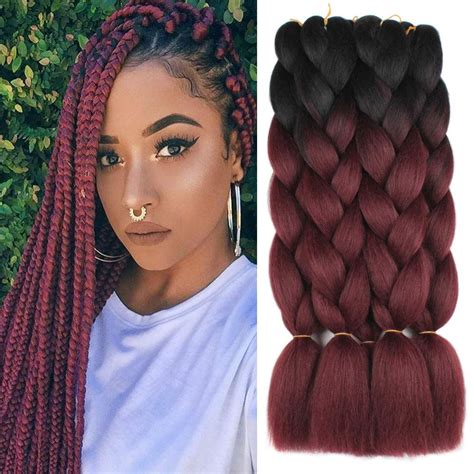Synthetic hair extensions offer a cost-effective solution for those seeking luscious, voluminous locks without breaking the bank. With a wide range of textures, colors, and lengths available, synthetic braids cater to diverse tastes and hair needs. This extensive guide explores the benefits, challenges, and best practices associated with synthetic braid extensions.

Types of Synthetic Braid Extensions
Synthetic braid extensions come in a variety of forms, each with its own unique characteristics:
- Kanekalon Braids: The most common type of synthetic braid, known for its silky texture and vibrant colors. Affordable and easy to maintain.
- Jumbo Braids: Thicker and more voluminous than Kanekalon, Jumbo braids provide a bold and dramatic look.
- Senegalese Twists: These two-strand twists resemble natural hair and offer a protective style with minimal shedding.
- Box Braids: Interlocking three or more strands of hair, Box braids create a structured and versatile look that can be customized to suit various preferences.
- Passion Twists: A combination of two-strand twists and Senegalese twists, Passion Twists create a full and natural-looking style.
Benefits of Synthetic Braid Extensions
- Affordability: One of the primary advantages of synthetic braid extensions is their budget-friendliness. They are significantly cheaper than human hair extensions, making them an accessible option for individuals with limited funds.
- Convenience: Synthetic braids require less maintenance than human hair extensions. They can be washed and styled easily, saving time and effort.
- Versatility: With a vast selection of textures, colors, and lengths to choose from, synthetic braid extensions provide endless possibilities for customization. They can be styled in various ways to suit different occasions and preferences.
- Protect Natural Hair: Synthetic braid extensions can protect natural hair from damage caused by heat, styling products, and environmental factors. They act as a barrier between the hair and harmful elements, promoting healthy hair growth.
Challenges of Synthetic Braid Extensions
- Heat Sensitivity: Synthetic hair fibers are not heat-resistant, which means they can melt or become damaged when exposed to high temperatures. Therefore, heat styling tools should be avoided or used with caution.
- Shedding: While less prone to shedding than human hair extensions, synthetic braids can still shed slightly, especially at the roots. This is a normal occurrence that can be managed by regular brushing and tightening.
- Durability: Synthetic braid extensions are not as durable as human hair extensions and may need to be replaced more frequently. However, with proper care, they can last for several months.
- Unnatural Feel: Depending on the quality of the fibers, synthetic braid extensions may feel somewhat unnatural to the touch compared to human hair extensions.
Best Practices for Synthetic Braid Extensions
- Choose High-Quality Fibers: Invest in synthetic braids made from high-quality fibers to minimize shedding and ensure longevity.
- Avoid Heat Styling: Limit the use of heat styling tools or opt for low-heat settings to prevent fiber damage.
- Regular Maintenance: Wash and condition synthetic braids regularly to keep them looking fresh and prevent tangling.
- Gentle Detangling: Use a wide-tooth comb or your fingers to gently detangle synthetic braids to avoid breakage.
- Tighten Regularly: Check the tightness of your braids periodically and tighten them as needed to prevent slipping or shedding.
Applications of Synthetic Braid Extensions
Beyond traditional uses for adding length and volume, synthetic braid extensions can also be applied creatively to create unique hairstyles and transform the overall look of your hair:
- Braid Crowns: Weave synthetic braids into a crown shape around the head for a regal and elegant style.
- Chunky Highlights: Incorporate synthetic braids of contrasting colors into your natural hair to add pops of vibrant color and dimension.
- Hair Accessories: Use synthetic braids to create hair accessories such as headbands, barrettes, and hair wraps for a touch of flair.
- Protective Hairstyles: Synthetic braids can be used to create protective hairstyles such as box braids, Senegalese twists, and cornrows to promote hair growth and minimize breakage.
Tables for Decision-Making
Table 1: Comparing Synthetic Braid Extension Types
| Type | Texture | Volume | Durability |
|---|---|---|---|
| Kanekalon | Silky | Medium | Low |
| Jumbo | Coarse | High | Medium |
| Senegalese Twists | Soft | Medium | High |
| Box Braids | Thick | Low | High |
| Passion Twists | Curly | Medium | High |
Table 2: Pros and Cons of Synthetic Braid Extensions
| Pros | Cons |
|---|---|
| Affordable | Heat sensitive |
| Convenient | Can feel unnatural |
| Versatile | Less durable than human hair extensions |
| Protect natural hair | Can shed slightly |
Table 3: Maintenance Tips for Synthetic Braid Extensions
| Task | Frequency |
|---|---|
| Shampoo and condition | Every 1-2 weeks |
| Detangle | Daily |
| Tighten | As needed |
| Avoid heat styling | Always |
Table 4: Creative Applications of Synthetic Braid Extensions
| Application | Style |
|---|---|
| Braid Crowns | Regal and elegant |
| Chunky Highlights | Vibrant and dimensional |
| Hair Accessories | Unique and eye-catching |
| Protective Hairstyles | Promotes hair growth and minimizes breakage |
Conclusion
Synthetic braid extensions offer a budget-friendly and versatile way to enhance the length, volume, and style of your hair. With proper care and maintenance, they can provide lasting results without breaking the bank. Whether you seek a protective style, a bold statement, or simply a touch of flair, synthetic braid extensions empower you to express your individuality and achieve the hair of your dreams.
